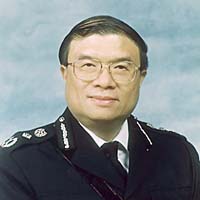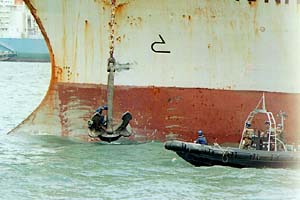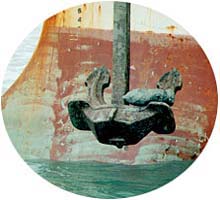




















| ||
 | "As we look back over another eventful and historic year
and turn our thoughts toward 1998, I and my wife would like to wish all Force members -
Regulars, Auxiliaries and civilians - and their families, a joyful Christmas and a happy, healthy
and prosperous New Year."
| |

| ||
 
Dealing with the worst. With his No.2 anxiously watching as he evacuates the area, Bomb Disposal Officer Jimmy Yuen prepares to deal with a 500 pound aircraft bomb in an interesting situation | ||
|
When a jumbo jet skidded off the tarmac at Kai Tak blocking the only runway of Asia's busiest airport, the EOD cleared the way in a classic example of explosives engineering by chopping off the jet's tail-fin with a controlled explosion. And when management of a hotel in Causeway Bay phoned police after receiving a bomb threat linked to a suspicious package left in its coffee shop during the recent World Bank-IMF Monetary Fund meeting in Hong Kong - it was the Explosive Ordnance Disposal Bureau who handled the matter. "EOD forms an essential part of the Force's internal security structure," said Senior Bomb Disposal Officer Dominic Brittain. "The Bureau's responsibilities include ammunition and explosives inspection throughout the Force to ensure it's fit for use and stored properly; testing new ordnance such as CS grenades; and providing explosives engineering expertise for the Force or the Government. But basically we are responsible for all the bomb disposal work in Hong Kong." As if to emphasis the point, an old British military 105mm shell (now a trophy) stands on the floor of EOD headquarters in Arsenal House. Ten days earlier it was unearthed at a construction site on Castle Peak. "It was still fused and ready to go," recalled Mr Brittain. "But we were able to set a cutting charge along its shell, access its explosives and make it safe." According to the EOD Bureau's head, the most dangerous bombs his unit must deal with are the US 500-pound bombs dropped during the Second World War because of their still functioning mechanical fuses which were routinely booby-trapped. The Japanese 50-kilogramme white phosphorous bombs from the same period with their buster charges that set off an unstoppable burn that consumes everything in its path are just as diabolical. "Training of other formations is another large part of the EOD's work," Mr Brittain continues. "We give lectures and courses to PTS, CID, Airport Security Unit and Special Duties Unit officers (to name a few) to make sure their basic response to bomb incidents is at the right level. |
|
Although terrorist attacks are thankfully few and far between in Hong Kong, it frequently plays host to world political and economic leaders, and today the Explosive Ordnance Disposal Bureau remains extremely well-trained, equipped and prepared for the unthinkable - a precaution aimed at ensuring the safety of the public and the stability of the HKSAR. At the core of the EOD Bureau is an eight-member unit consisting of the senior, plus three other bomb disposal officers (called No. 1's), and four No. 2's. They comprise four two-member bomb disposal teams with the No. 1, who deals with, and disposes of the bomb, in charge; and the No. 2, who prepares all the equipment, remotely controls the bomb disposal robot, and gives technical support. The No. 1 undergoes a four-year training course conducted in Hong Kong and overseas. The No. 2 does a two-year training course in Hong Kong. Both are heavily examined and require a high degree of technical competence. Once officers have passed the respective courses they become specialists in the Bureau and remain there for the rest of their police careers. "The ability to make a crucial decision, intelligence, logical and lateral thinking are also vital in our officers, so when faced with a problem several different solutions can be seen and, by the process of elimination, the correct one chosen. Everything must be taken into account," said Mr Brittain. "Bomb disposal is a thinking game, with most of it being done in the planning stage. If you get the planning right, all the bomb disposal bit is just following the plan. If you get it wrong - somebody may die." Which is why the EOD Bureau's approach to discipline is different from a standard police formation. |
| |
|
"We are extremely harsh if a mistake gets made on a safety point," said Mr Brittain. "Everything is safety orientated. If a No. 1 or No. 2 makes one serious safety error in his two or four-year training course - we sack him. We enforce zero-tolerance of professional error. Everybody learns to live in that environment and mindset. It works very well and you develop an instinct for it. Officers then start investigating why their instinct is telling them that something is wrong, so that caution becomes inbred." "But even with our degree of professionalism, I cannot guarantee what will happen tomorrow. The unfortunate thing about bomb disposal is that you can do everything exactly right - but all you have done is reduced the risk which is never zero. You have to accept that. But I believe by using the training and the equipment properly you reduce the risk as close to zero as possible." The Bureau's zero-tolerance of professional error, methodical approach and dominant use of state-of-the-art technology, robotics and equipment to reduce risk has led to an enviable safety record. Since its formation in 1971 there have been no deaths - and no serious injuries. In fact, vacancies in the EOD Unit are infrequent. "So we tend to get to know each other very well," said Mr Brittain, citing a good sense of humour as a trait shared among EOD Bureau members. "If you can't step back and look at things from an outside perspective (which is what humour is) then you will start becoming a basket case very quickly. We're a very close-knit family, which is why it's vital that the right people are recruited." Part of the essential make up of the EOD Bureau is its cadre - a group of regular inspectorate officer volunteers who become an operational part the EOD Bureau and help assist its permanent members with bomb disposal duties during times of potentially high EOD activity, such as when International Protected Persons visit Hong Kong. "The cadre is very important and is called upon when we get swamped with work." explained Mr Brittain. "We had four extra teams on during the handover period and couldn't have seen it through without their help." Cadre members must successfully complete a six-week, full-time basic bomb disposal programme - the Improvised Explosive Device Disposal training course. They then must come back every year and re-licence in an extremely tough, two-week course that is almost entirely practical. There's one day in the classroom, with the rest of the time being spent in explosive work in the EOD's range at Mount Butler Quarry where they go through very realistic bomb disposal exercises. Two such EOD cadre members are SIP Graham Mitchelmore of the Airport Security Unit and SIP Gareth Ho Yiu-cheung A&S SUP CRIME HKI, who recently attended their annual re-licensing course. It wasn't easy. "They get tired and they get pushed very hard during re-licensing," said Mr Brittain, adding that he's very proud of, and thankful to, the cadre members. "They're all volunteers. They get no extra money, no recognition. They do it because they want the challenge and they want to help. They do it out of a sense of duty." Indeed, in one of the exercises SIP Mitchelmore and SIP Ho must respond to an emergency call in which a suspected package bomb is discovered in a room. What they don't know is that package is a decoy (empty). The real bomb is hidden and connected to a tripwire suspended at shoulder-level just beyond the doorway into the room. To make the exercise as realistic as possible, if snagged the tripwire will set off a real explosion - in this case a "banger", which is a small charge. Although the banger won't injure the No. 1 when wearing a bomb suit, it packs enough punch and decibels to demand the utmost caution and respect. They get four hours to complete the exercise, which is the second of three exercises the two-man team (alternating in roles as No. 1 and No.2) must complete on that day alone. "Yes it's tough work, but I enjoy being tested," said SIP Mitchelmore, who, as a member of the Airport Security Unit, joined the EOD cadre to raise his professional knowledge and skills in the disposal of bombs. "As a No. 1, you challenge yourself to the extreme - and in turn grow and develop. The toughest aspect is to keep calm and focused when things don't go exactly as you hoped they would. EOD work demands total concentration on the job at hand. You're forced to solve mental problems and to take control of a situation unlike in any other job of the Force." Physical fitness is also important. The bomb disposal suit weighs more than 60 pounds and the cooling suit weighs another 30 pounds. Walking 100 metres when you're scared in 90 pounds of Kevlar, carrying maybe up to 50 pounds of equipment, then working at the bomb site in Hong Kong's climate requires stamina. "In terms of the risk and danger involved, we push the safety side extremely high," continues SIP Mitchelmore. "If the call is real, we already have info on the situation before we arrive, so we can discuss the job on the way. When we get there, we calm everybody down, check the cordons and can spend time planning what to do. Then, having taken everything into consideration, you can then get up and deal with the bomb. You've got the time, the equipment and the planning to cut down the risk." Said SIP Gareth Ho Yiu-cheung: "On a real bomb call the work is more dangerous and risky than everyday policing. Having said that, the actual period we expose ourselves to such a high risk is minimal compared with an Emergency Unit crew whose every call is potentially dangerous." Which is probably why most of the EOD members are ex-Emergency Unit personnel. They rely on one another to stay alive and every single person has got to get it absolutely right. SIP Ho also says one of the most attractive things about bomb disposal is that its officers never finish learning: "Every incident demands that you gather information, evaluate it then carry out the plan. Even straight-forward cases have to be considered very carefully. Every situation is different and if you don't treat them as such you will find yourself trapped. In EOD the more you learn and experience the less risky it is." "There's a lot contradictions in the EOD cadre," says IP Marine South Alick McWhirter, who was called upon to work with the Bureau during both the handover and the World Bank-IMF Meeting. "When you're the No.1 you're in charge of the job - it's a very isolated position. But when you're in cadre training there's a lot of camaraderie and team work. "Also, in training you're given a cast iron set of rules to follow called Standard Operating Procedures (SOPs). But having been given those, you have to be totally flexible in a bomb situation and may have to disregard SOPs at any given time. If you do, though, you answer to the Senior Bomb Disposal Officer when you get back to base. In writing." Inspector McWhirter was the No. 1 who, along with his No. 2, dealt extremely successfully with the package bomb (a hoax as it turned out) in a Causeway Bay hotel last September. He describes that experience as "extremely satisfying". "Unlike anywhere else in the Force, being a part of the EOD cadre allows someone at inspectorate level the opportunity to assess a situation, take control and deal with it. During the bomb hoax at the hotel, I turned up, and although the DVC Wanchai was the cordon commander, and as the Bomb Disposal Officer, in effect for a time I was in charge of the cordon and above him. When things go right, you really get a charge out of it." | ||
|
|
Adds IP McWhirter: "You hear about the EOD cadre team from people who are in it, but until you join you really can't understand just how excellent the training is, or how challenging the job can be." THE EOD cadre is currently nine inspectorate officers strong, although the ideal number is reckoned to be fifteen. To augment the cadre a full-time, six-week training course in bomb disposal duties is planned to be held between 22 March and 2 May, 1998. Officers who think they have the right stuff and want to join the EOD cadre should apply for the opportunity to be selected for this training before the deadline - 5 January 1998. Further details regarding the selection and training can be obtained from HQO141/97, or from Mr D J Brittain, SBDO on 2860-2500. | |

